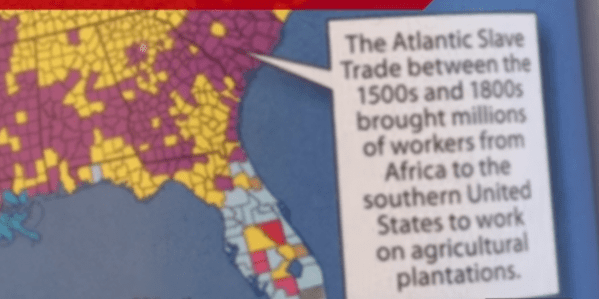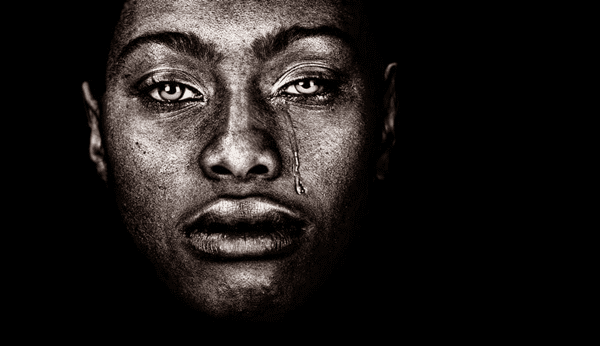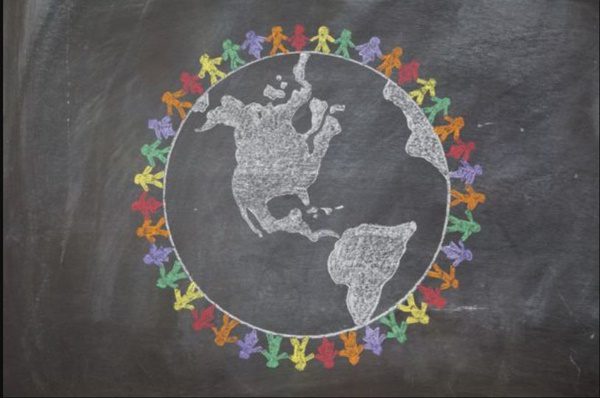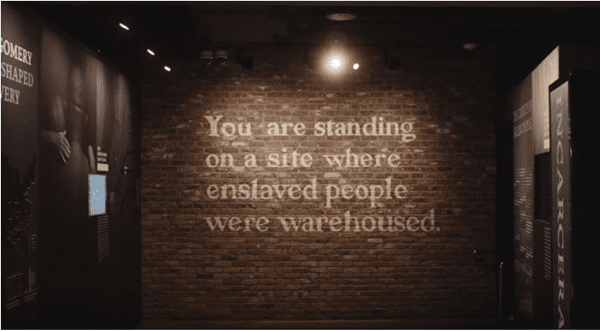
Workers?
We was real hard workers, wasn’t we?
With those words, 15-year-old Coby Burren alerted his mother, Roni Dean-Burren, to a mistake somehow overlooked by editors and reviewers held to what one would hope to be the highest standards of scrutiny. In his 9th grade World Geography book, a text used by millions of students nation-wide, he had found slavery described as a type of “immigration” and slaves euphemized as “workers.” The caption read:
The Atlantic Slave Trade between 1500 and 1800 brought millions of workers from Africa to the Southern United States to work on agricultural plantations.
Proud of her son’s keen mind and sharp eye, but alarmed by the revisionist history, Dean-Burren, a former high school English teacher who is now a Ph.D. candidate in education at the University of Houston, posted her son’s textbook on Facebook in a video expressing her disappointment. The video went viral, and before long Dean-Burren was invited to express concerns — by then shared with parents across the nation – on such programs as Good Morning America and The Nightly Show With Larry Wilmore.
Her criticism also caught the attention of the publishing company, McGraw-Hill, which consented to changing the wording in the digital version of the book immediately and making sure the next edition contained new wording to replace “workers” with “slaves” and describe slavery as a “forced migration.” Not yet satisfied, as this particular new book could remain in classrooms for up to 10 years, Dean-Burren and her supporters continued to press the issue. Eventually the CEO of McGraw Hill, David Levin, extended a personal invitation to Dean-Burren for a meeting. Levin explained multiple steps the company would take to rectify the situation, including sending stickers that would cover and correct the misinformation on the caption. He also informed her that McGraw-Hill is developing a lesson plan so that teachers can guide students through making the corrections themselves and use the incident as a teachable moment. For school districts that make the request, McGraw-Hill will recall and replace the textbooks without charge. Additionally, McGraw-Hill is sending Dean-Burren further textbooks for her to check. Last week she received a copy of United States History to 1877, and she’s getting to work. Through her tireless diligence and dedication to educating youth with truth, Roni Dean-Burren has more than earned her Stay Woke award!
Mythology
The rest of us need to stay woke too, because, as Dean-Burren says, “Erasure is real.” My understanding, not only from following this story closely, but from what I have learned from intentional study of institutional racism and a Girardian understanding of the human condition, is that this mistake was a purposeful euphemism, a mythologizing of history. I do not believe harm was intended, but harm is the inevitable result of minimizing the inexcusable abomination of slavery in all of its abject cruelty.
Remembering the past – literally re-membering, or putting it back together in our minds and our personal narratives – to emphasize the good and minimize the horrific or embarrassing, is a human tendency that dooms us to repeating, in new and varied nuanced ways, our mistakes and follies. For those who hold power or advantage over others, this human tendency is a building block of our culture, a culture built on the backs of victims and covering over their presence. In other words, as the cliché goes, “history is written by the winners,” but the re-writing of history to obscure mistakes and poor judgments makes losers of us all.
The Girardian term for this re-writing of history is “mythology.” While the conventional understanding of classical mythology is that it consists of stories told, in metaphoric language, to reveal deep truths, René Girard understood myth to conceal a deep truth, the truth of our violence. Girard convincingly exposes ancient myths as retellings of actual human violence, obscuring such violence with overlays of gods and glory. The development of human culture has been structured on violence and the covering of such violence to build collective bonds of pride at the expense of victims. (For more on the connections between history, mythology, and culture, see Imitatio’s introductory page on René Girard). When any history, including modern history, is told by those in power in such a way as to minimize or obscure the violence done to the oppressed, it is not truth but mythology. And mythology that obscures violence perpetuates violence.
Racism
Mythology, in the form of white denial and a white-dominant narrative of history, has been a structuring principal of this country from the very beginning. A country built on stolen land and stolen labor has racism at its core, racism obscured by euphemizing mythology. While the history of slavery, Jim Crow laws, lynching, and a long and bloody civil rights movement is more-or-less common knowledge, the interpretation of these facts of United States history varies widely according to factors including race and one’s place within a power-structure that was built on the oppression and exploitation of black lives. In my “Dismantling Racism” series, I wrote that the ongoing impact of racism is much less understood than its past manifestations:
Less is known about the ways in which racism is built into the very structure and economy of modern American life. Less is known about strategic decisions that are made that keep black lives devalued.
In other words, mythologizing the racism of this country, obscuring the structural role it plays, is nothing new. In fact, the terrible history of slavery and segregation in this nation has been written into a dominant narrative of “overcoming obstacles.” The narrative that racism is a thing of the past, outlawed and outdated, obscures a continued need for repentance and growth toward a racial equality (in terms of social, political and economic opportunity) that still eludes our nation. Personal animosity based on race, or racial bigotry, is rightly condemned by most, but because of that, institutional racism has become more insidious. The power dynamics of white privilege are often invisible to the privileged.
The invisibility of racism to those who wield it makes it all the more difficult to confront and combat. Because racism is considered “over” by an unrepentant (un-self-critical) nation, I believe that the editors at McGraw-Hill, and the many reviewers, saw no harm in categorizing slavery as “immigration” and euphemizing slaves as “workers.” After all, they probably reasoned, Africans traveled to America and they worked. The fact that this “migration” was in fact a kidnapping, the stealing of human lives on a massive scale, the packing of people chained together into ships unfit for transporting animals, and that the “work” they did was enforced with unspeakable and often deadly brutality, was left unmentioned, at least in this section. Perhaps the editors believed that all of this was implied, but the euphemisms that obscure this reality are the tools that chisel history into mythology to tell a story less damning.
But the consequences of racism and “erase-ism” are ongoing and intensifying as our nation becomes increasingly polarized, not necessarily along racial divisions, but along divisions between those who acknowledge and those who deny white privilege. The truth is, the less racism is acknowledged, or the more it is considered a problem of the past, the worse this division becomes, with detrimental consequences to everyone but especially African Americans. Distancing ourselves from a horrific and embarrassing history of unspeakable brutality denies how deeply-rooted and far-reaching racism still is. Mythologizing the past blinds us to the damning facts of the present, including the fact that economic opportunities historically denied to African Americans accounts in part for a wealth disparity wherein the average black household has only 6% of the wealth of the average white household. Racial profiling, police brutality, and a racist mass incarceration system has been in the spotlight this year, but attention to these atrocities has also generated pushback by those who chose to double-down on their denial. Sanitizing the brutality of the past absolves white people — collectively — of our responsibility in creating an unequal, exploitive system that has lead to poorer housing, poorer school systems, and fewer economic opportunities for African Americans. And the less we acknowledge our responsibility, the more we blame those hurt by racism for the inequalities imposed upon them.
Repentance
The human capacity for denial, self-justification, and deflecting responsibility is limitless. This individual tendency is reinforced by mimesis (spread like a contagion via imitation through society) in the collective whitewashing that mythologizes our cultural narrative. The vocabulary chosen for the caption in the McGraw-Hill textbooks, and the decision to mis-contextualize slavery as immigration, is one example of such mythologizing. One consequence of such mythologizing is continued blindness to racism, as well as blindness to other imbalances of power and continued policies of violence and oppression.
Our cultural mythology keeps us entrapped in a system that perpetuates injustice along racial divisions. Only the truth can set us all free. The truth, in all of its ugly horror, is that the United States has never overcome its brutal origins in the most dehumanizing treatment of fellow human beings. Whitewashing history, or “rewriting it with a pencil instead of a bleeding pen” as Roni Dean-Burren says, ensures that we move farther away from rather than closer to the equality we claim as a hallmark of our nation.
We are long overdue for repentance, for turning ourselves around. Repentance is acknowledging our diagnosis as a sick society in need of healing, and from that acknowledgement, turning ourselves around in honesty and humility. We must turn from denial to awareness, from perpetuation of injustice to reparation for injustice. Teaching the truth, not only about slavery, but about the continued influence of racism, along with every other evil that must be brought from the shadows into the healing light of day, is where we must start.
Stay in the loop! Like Teaching Nonviolent Atonement on Facebook!











